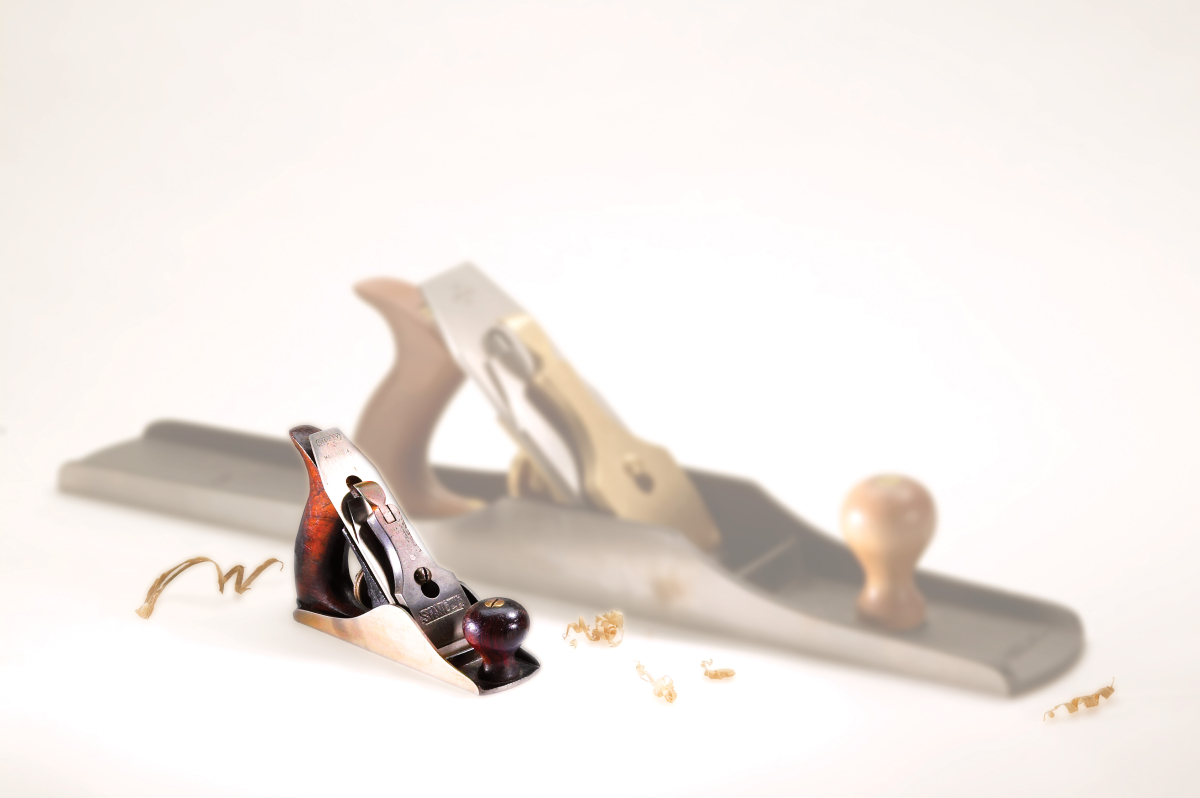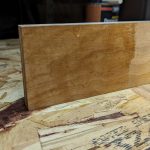We may receive a commission when you use our affiliate links. However, this does not impact our recommendations.
 It sure is cute – but is it useful?
It sure is cute – but is it useful?
Few tools spark the affection of so many as the Stanley No. 1 size bench plane. Regardless of one’s interest, the small plane has a way of catching everyone’s eye. Set one on a table at a tool show and nearly everyone who walks by will stop to look it over and check the price. When conversation starts, two comments are always heard. First, “What a cute little plane.” And second, “How did they ever use such a small thing?” I am intrigued by this question and have been collecting uses for this tiny bench plane for years. My list of documented uses now numbers eight and continues to grow slowly. I’ll share some of these uses with you, but first some background.
The first metal No. 1 was most likely made by Leonard Bailey in Boston by 1865 (or slightly earlier). From looking at existing examples and catalogs, it seems clear that the No. 1 followed roughly the same development as the larger Stanley bench planes. As major changes took place in the larger planes, similar changes, when applicable, can be found in the No. 1. Exceptions to this rule are the plane’s lateral adjustment lever, some frog redesigns and the 1910 frog-adjuster screw, as these parts were never incorporated into the No. 1.
No less than five different companies offered a similar miniature plane: L. Bailey, Stanley Rule & Level Co., Ohio Tool Co., Union Manufacturing Co. and Chaplin. The little planes were all more or less 51⁄2” long with 11⁄4“-wide cutters. The Ohio Tool Co. was the only company to offer a version with a corrugated sole. In addition to Stanley’s regular production, Stanley also made a “Liberty Bell” model in the 1870s and the “Defiance” model in the 1927 to 1929 period. Stanley was the last company to manufacture the plane and stopped catalog offerings in 1943. So all told, the little No. 1 plane was a hit on hardware store shelves for more than 78 years.
But the tale of the smallest bench plane doesn’t end there; Lie-Nielsen Toolworks reintroduced production of the No. 1 in the late 1980s. The Lie-Nielsen No. 1 is produced with a bronze body but is otherwise very similar to the traditional iron-bodied Stanley version.
So why did the No. 1 plane exist? Stanley was a successful company and the reason it manufactured the No. 1 plane was because it sold. Sales may have not been in the millions but were clearly adequate enough to keep this jewel in the pages of the catalogs for years. Only the cultural transformation of World War II was able to halt production.
So why was the plane so popular long before modern-day collectors decided it was cute?
A Number of No. 1 Uses
My first documented use was by beekeepers. Beekeepers work far from a workbench and the small plane was easy to tote about. The honey that the keepers take from the bees is stored in a separate section of the hive called a super. The super sits on top of the main hive and must fit tight to the hive or the bees waste time filling the joints with wax. The No. 1 was used for adjusting the edges when fixing a super to a hive in the field.
Another user of the plane was the bamboo fly-rod maker. Cane rods are constructed in six sections, carefully planed to form a hexagon. The No. 1 worked like a charm for this delicate work with the soft, stringy bamboo.
For much the same reasons as the beekeeper, the wood shingle installer and trim carpenter also used the No. 1. The small size and narrow width fit easily into the bib or overalls pocket, whereas a block plane with its 15⁄8“-wide cutter was often too wide.
The boatbuilder found the No. 1 useful for fitting and shaping the laps and gunnels of small wooden boats. The small size allowed access into tight spots up to the very ends of the boat, while the higher cutting angle of the tool (45°) made working softwoods such as cedar and pine a breeze.
Linenfold panels are another example of where the plane is just the right size and shape. The flowing curves run the length of the panels and require considerable hand shaping. The plane’s narrow width and upright profile make it ideal for this type of work.
The work of the house carpenter was often outside in the cold and always demanded a strong grip. The constant use and cold took their toll on the hands and arthritis was a common ailment. The No. 1 plane was the solution. The higher profile of the plane (compared to a low-slung block plane) offered more meat to grip and did not require that the hand close as tightly. Therefore, as a carpenter aged, the No. 1 often became a necessary replacement for his block plane.
The only group found to date to actually hold the No. 1 bench plane in a traditional manner is young trade school students. Smaller hands allowed them to hold the plane by the handles and push it along much as an adult would use a No. 5 jack plane. Over the years, many No. 1 planes have turned up at trade school auctions. One auction in the 1960s sold cafeteria trays full of No. 1 and No. 2 planes for mere peanuts; boy, have times changed! Now, they’re highly sought after at auction where good examples can fetch thousands of dollars.
One popular theory is that the small plane was a salesman’s sample. I doubt this use was widespread and was certainly not the reason for manufacturing the plane. However, the quality construction and small size would certainly make the small plane a convenient sales tool. One story is of a Stanley salesperson who did a number of trade shows carrying a Stanley No. 1 in his pocket. The plane was attached to a chain hooked to his belt. When the timing was right, he would pull the chain, whip out the No. 1 and hope to hammer home a sale.
More uses certainly exist but three things seem clear: the smaller size, the tool’s high profile and its 45° cutter pitch were keys to its longevity. Today, many of us like to look at the shelf and think we know a new reason, but just maybe there was a carpenter or two in the 1890s who salted a No. 1 away in the corner of his box just because it was cute.
Dating Your Plane
Much confusion exists in determining the exact age of a Stanley No. 1 plane. In general, it is accurate to say the plane follows the types as defined in Roger Smith’s type study in “Patented Transitional & Metallic Planes in America 1827-1927.” However, production differences and missing types do exist and need to be allowed for.
The No. 1 was not equipped with all the features offered on larger planes. The most notable missing items are the lateral adjustment lever, the recessed adjuster knob and the frog adjustment screw. Therefore, as these features were added to the bench plane line, the No. 1 would have remained unchanged making for fewer, longer-produced types. It is recommended that Smith’s Type Study be followed and types such as Type 5 be simply noted as not produced in the No. 1 size.
Author’s Note: Stanley often used parts with earlier trademarks or stamps long after redesigns had been introduced. Dating by mark is an indication of a “not earlier than” date – not a production date. Many tools sold in the 1930s had the Rule & Level trademark. Always remember, Stanley did not have the type studies when they assembled the tools.
Here are some supplies and tools we find essential in our everyday work around the shop. We may receive a commission from sales referred by our links; however, we have carefully selected these products for their usefulness and quality.



 It sure is cute – but is it useful?
It sure is cute – but is it useful?




